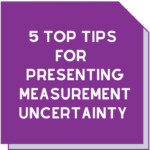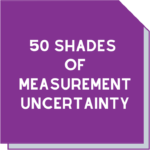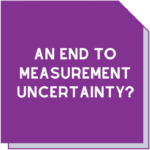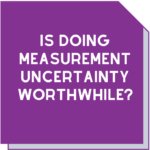Measurement Uncertainty: More than just the numbers
 How many times have you laboured away at doing Measurement Uncertainty, wondering what’s the point, besides ticking the NATA box? Do you even know what you’re doing in the first place?
How many times have you laboured away at doing Measurement Uncertainty, wondering what’s the point, besides ticking the NATA box? Do you even know what you’re doing in the first place?
Well, the good news is that there is a point beyond simply complying with accreditation requirements, There are so many more things to MU than just the numbers. We explore some of these in this article.
The ‘WHY’ of MU is not just about accreditation
MU is an important tool for your lab and the people you provide your results to. The MU process is critical to making decisions and assessing risk. It goes to the heart of why we have a quality management system.
MU can help determine where you spend money on calibrating equipment and how often. Developing a good MU budget can also help to ensure that the new equipment you’re planning to invest in will deliver the best possible results.
Often labs experience a series of nonconformances, observations, and questions about MU, from their accreditation body (AB), such as NATA. Staff can find themselves in an MU snag and unable to break free.
Whenever you are on the receiving end of a rejection about your MU submission from your AB, persevere! Remember that there is more to it than the numbers and you need a good strategy.
By developing an appropriate strategy, you can learn how to meet NATA’s requirements not only on MU, but also on equipment assurance, in-house calibration, equipment verification and monitoring competence of staff.
How do you do this? When thinking about MU, you should:
- Consider all the factors
- Document your process
- Reference your MU sources
- Use spreadsheets
- Define your origin
Let’s investigate this in a little more detail.
Consider all the factors
 When you develop your MU budget, don’t dismiss an uncertainty factor without having evidence that the factor is negligible. This applies whether the evidence is a result of your own experiments or from the published research of other scientists and labs.
When you develop your MU budget, don’t dismiss an uncertainty factor without having evidence that the factor is negligible. This applies whether the evidence is a result of your own experiments or from the published research of other scientists and labs.
You’ll need to present this evidence to the AB. Remember, just because a value is under the allowed interval or is small, doesn’t mean that there is no uncertainty. In addition, having this evidence demonstrates to the AB and the Technical Assessor that you understand the principles of MU and the method you’re using.
Reference your MU sources
There are quite a number of published documents describing how to calculate MU. Some examples of valid sources are industry journals, publications from professional societies, advice from industry experts, and scientific papers. The key word here is ‘valid’. Wikipedia, while a useful source of information, is not the best ‘go to’ place for information when it comes to dealing with an AB!
Be sure to confirm that the method you’re relying on is applicable to your area of testing.
Provide the reference document to the Technical Assessor if copyright allows this to be done. This part is critical, particularly if you’re working in a new or innovative area of science. If you’re using a known industry method for developing your uncertainty budget, don’t assume that everyone knows of its existence.
The reference document will allow your Assessor to evaluate the technical validity of your uncertainty budget calculation.
Document your process
Prepare a document that describes the process you’re following to calculate your uncertainty budget. Include information on how the data was obtained, how it was used, and the calculation method itself.
Although this may take some time to prepare, it will give the staff developing MU budgets a consistent source of information. As a bonus, it will also mean that a Technical Assessor will have access to complete information about what you did and how.
Use spreadsheets
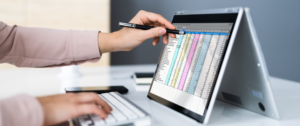 If you have a computer, you’ll have a spreadsheet program on it. Although it may not be fancy, it’s an excellent tool and can make your life easier.
If you have a computer, you’ll have a spreadsheet program on it. Although it may not be fancy, it’s an excellent tool and can make your life easier.
For example, let’s say you’re using an Excel spreadsheet to develop your measurement uncertainty budget. Rather than inputting the values directly, use cell references in your formulas instead.
This means that if you need to modify a value in your MU budget, you’ll only need to update one cell and click the save icon. The spreadsheet will do its magic and update all the calculations.
This will also help a Technical Assessor easily track and understand your calculations and make the process smoother for them.
Define your origin
Indicate the origin of the values used for your MU calculation. Specify if a value came from a calibration or reference standard certificate, a scientific article, or a standard. Explain to the Technical Assessor the values in your calculation and where they came from.
All of this will assist the Assessor in evaluating the technical validity of your MU budget.
Get some training
 If the thought of calculating MU makes you sweat, we have an excellent one-day training course you must attend.
If the thought of calculating MU makes you sweat, we have an excellent one-day training course you must attend.
Participants bring along a method and associated information and work through an example from their laboratory. This means that they’ll use a real-world example, which means immediate benefit back in the lab.
By developing an appropriate strategy, participants learn to meet NATA’s requirements for equipment assurance, in-house calibration, and equipment verification. The principles covered in this course can be extended and used to make decisions about:
- targeting competency assessments and training programs
- conducting equipment checks in-house or sending them out for calibration
- purchasing new equipment
- improving method performance.
Our next Measurement Uncertainty course is just a couple of weeks away on 14 February. Head over to our course registration site. We offer in-house training too, so if you’d like a few staff to learn the ins and outs of MU, then get in touch at info@masmanagementsystems.com.au .
Contact Maree (0411 540 709), or email info@masmanagementsystems.com.au to set up a confidential discussion.
Remember, you don’t have to do this alone!
Download the article Measurement Uncertainty: More than just the numbers


